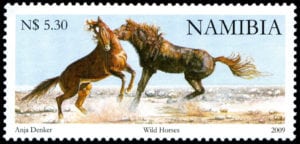Namibia is purported to have some of the most beautiful postage stamps in the world. But what’s more fascinating are the stories behind the artful images they depict—plant and animal life, traditional cultures, history—and landmark events. Many people are unfamiliar with Namibia—until they visit on our motorcycle safaris and fall in love with it. The stamps have inspired us to share morsels of its rich character.
This month we examine the history of two stamps depicting the country’s proud and fierce independent spirit.
Namibia’s Independence: More Than 300 Years of Resistance
“It is January 1677. At the tip of Africa, where a supply station has been established at the foot of Table Mountain, the Dutch ship “Bode” sets sails to explore the coastline north of the Gariep/Orange river mouth. In early March the “Bode” arrives at Sandwich Harbour. The crew goes ashore but is attacked by the Khoisan who live there. After a brief skirmish the sailors retreat back to their ship and leave the bay. This was the first resistance by the inhabitants of today’s Namibia against European intruders and resistance continued for more than three centuries.”[1]
A hundred years later Europeans began to trickle back as explorers, hunters, traders and lastly missionaries were welcomed, ostensibly for the European arms and merchandise they exchanged for livestock. As Namibia’s strategic location and cheap natural resources increased European desire for industrialization and colonization, so too did the citizen’s resistance to outside influence, particularly from Germany.
In a common colonization theme, a battle for independence in 1903-1908 was lost, with land confiscated and sold to settlers. The Namibian’s plight did not improve when South African troops defeated the Germans in WWI . The resistance remained alive, with a violent rebellion in 1959 followed by a massacre three months later.
In the 1980’s events thousands of miles away changed the course of history. Set in motion by the impending collapse of the Eastern Block and the provision of humanitarian and military strength from the United Nations, Namibia finally celebrated independence on March 21, 1990, 313 years after the arrival of the “Bode” in Sandwich Harbour.
Wild Horses: Embodying the Spirit of Namibia
 Perhaps nothing typifies Namibia’s spirit of freedom and adventure like the wild horses that have roamed its southwestern desert for more than a century. That they are said to have originated during the country’s fight for independence only strengthens their cultural symbolism.
Perhaps nothing typifies Namibia’s spirit of freedom and adventure like the wild horses that have roamed its southwestern desert for more than a century. That they are said to have originated during the country’s fight for independence only strengthens their cultural symbolism.
Legend has it that the horses belonged to both the Union forces stationed at Garub and a nearby stud farm. When the Germans bombed the base many of the horses escaped, surviving around mountain pools left from the rainy season. Horses bred for the racecourse and diamond mines joined them when their owner returned to Germany.
Over time, the horses returned to their wild nature, forming family groups and living according to natural ways and the seasons. Eventually they attracted the attention of the public and scientists who studied their effect on the natural biosphere, deeming it didn’t interfere with indigenous wildlife or vegetation.
Known as the Namibs, the horses have adapted to their harsh environment. Given their linneage, it’s no wonder. Public fascination has made them one of the country’s top tourist destinations. Watching them one can easily visualize their embodiment of the national character—“soulful, natural, rugged, and free”. [2]
Source:
Stamps and Stories, Vol. 1, 50 Stories on Namibia’s Postal Stamps, Gondwana Collection Namibia, & NamPost, 2012
[1] Stamps and Stories, Vol. 1, p.47
[2] Stamps and Stories, Vol. 1, p. 19


